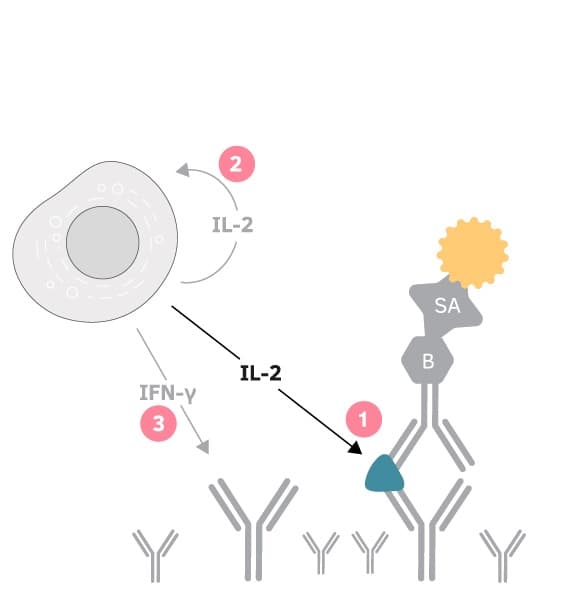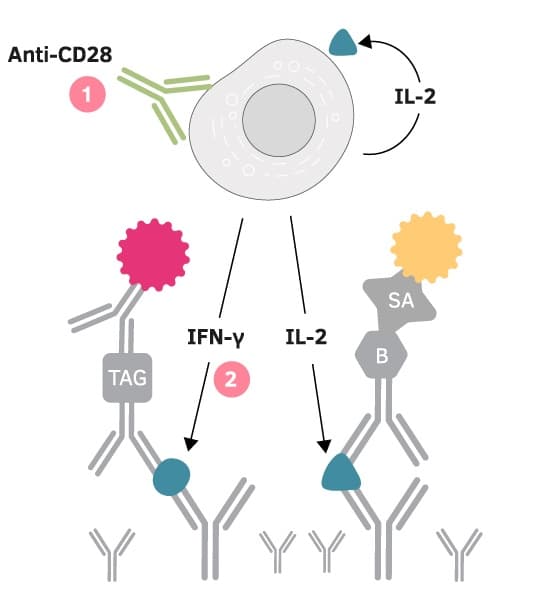The systems reactive with NHPs are either based on cross-reactive human kits or specifically developed monkey kits (NHP).
Cross-reactivity verification tests have been performed in ELISpot and/or ELISA by Mabtech and/or by others. Evaluations of assays with less solid evidence of cross-reactivity are shown as symbols within parentheses.
| ApoA1 | |||||||||
| ApoB | |||||||||
| ApoE (NHP) | |||||||||
| ApoE | |||||||||
| ApoH | |||||||||
| CCL2 (MCP-1) | |||||||||
| CCL4 (MIP-1β) | ( ) | ( ) | ( ) | ( ) | ( ) | ||||
| CCL22 (MDC) | ( ) | ( ) | ( ) | ( ) | ( ) | ||||
| CD25 | |||||||||
| GM-CSF | ( ) | ( ) | |||||||
| Granzyme A | |||||||||
| Granzyme B (NHP) | |||||||||
| Granzyme B | |||||||||
| IFN-α2 | |||||||||
| IFN-α pan | ( ) | ||||||||
| IFN-γ (NHP) | |||||||||
| IFN-γ | ( ) | ||||||||
| IgA (NHP) | |||||||||
| IgA | |||||||||
| IgG | |||||||||
| IgM | |||||||||
| INS | |||||||||
| IL-1α | |||||||||
| IL-1β | |||||||||
| IL-2 (NHP) | |||||||||
| IL-3 | |||||||||
| IL-4 | ( ) | ( ) | ( ) | ( ) | |||||
| IL-5 | ( ) | ( ) | ( ) | ||||||
| IL-6 | ( ) | ( ) | ( ) | ||||||
| IL-8 (NHP) | |||||||||
| IL-8 (ELISA) | |||||||||
| IL-8 (ELISpot) | |||||||||
| IL-10 (NHP) | |||||||||
| IL-10 | |||||||||
| IL-12/-23 (p40) | |||||||||
| IL-12 (p70) | |||||||||
| IL-13 (NHP) | ( ) | ( ) | ( ) | ||||||
| IL-13 | |||||||||
| IL-17A (NHP) | ( ) | ( ) | |||||||
| IL-17A | |||||||||
| IL-17F | |||||||||
| IL-17A/F | |||||||||
| IL-21 | |||||||||
| IL-22 | |||||||||
| IL-23 | |||||||||
| IL-27 | |||||||||
| IL-31 | |||||||||
| IP-10 | |||||||||
| Perforin | ( ) | ||||||||
| TGF-β1 (latent) | |||||||||
| TNF-α (NHP) | ( ) | ( ) | ( ) | ( ) | ( ) | ||||
| TNF-α | |||||||||
| CD3, mAb CD3-1 | |||||||||
| CD3, mAb CD3-2 | |||||||||
| CD28, mAb CD28-A | |||||||||
| IFN-γ mAb 1-D1K | ( ) | ( ) | ( ) | ( ) | ( ) | ( ) | |||
| IL-2 mAb MT8G10 | ( ) | ( ) | ( ) | ( ) | ( ) | ( ) | ( ) | ||
| IL-4 mAb IL4-3 | ( ) | ||||||||
| IL-17A mAb MT504 | |||||||||
| Perforin mAb Pf-344 | |||||||||
| TNF-α mAb MT15B15 | |||||||||
| IgG1 mAb MTG1218 | |||||||||
| IgG1 mAb MT1939 | |||||||||
| IgG2 mAb H6200 | |||||||||
| IgG2 mAb MTG211E | |||||||||
| IgG3 mAb MTG34 | |||||||||
| IgG4 mAb MTG42 | |||||||||
| IFN-γ mAb MT111W | ( ) | ( ) | ( ) | ( ) | ( ) | ( ) | ( ) | ( ) | ( ) |
| TNF-α mAb MT15B15 | ( ) | ( ) | ( ) | ( ) | ( ) | ( ) | ( ) |
Symbol keys:
Verified by Mabtech and/or by others. Tests performed in ELISpot and/or ELISA.
- good
- poor
- no
Based on reports from others or by analysis using recombinant proteins.
- ( ) good
- ( ) poor
- ( ) no
Specifically developed monkey kits are marked with (NHP).
Blank boxesRepresent cross-reactivities not evaluated.
* Comprises several species. Cross-reactivity may have to be verified on a species basis.


